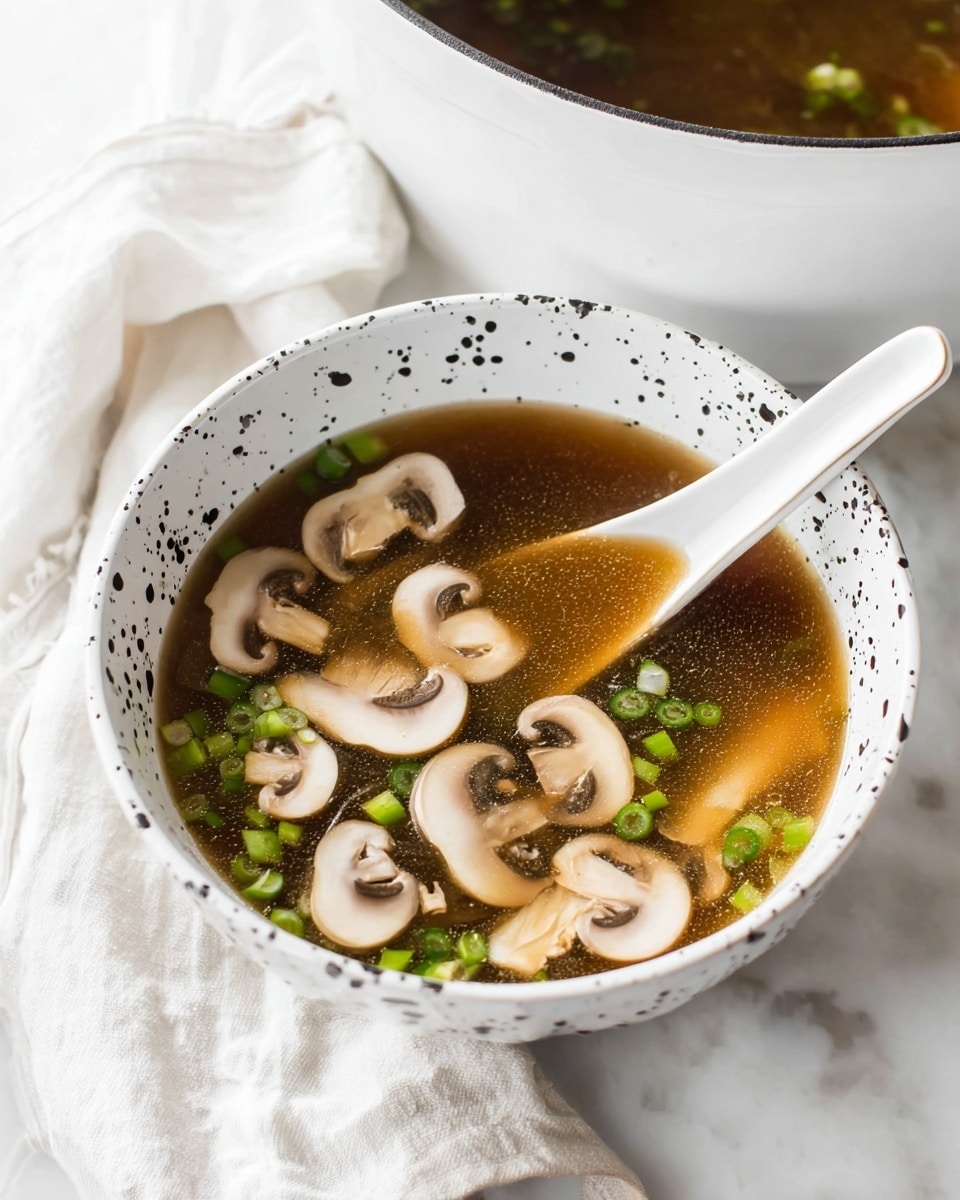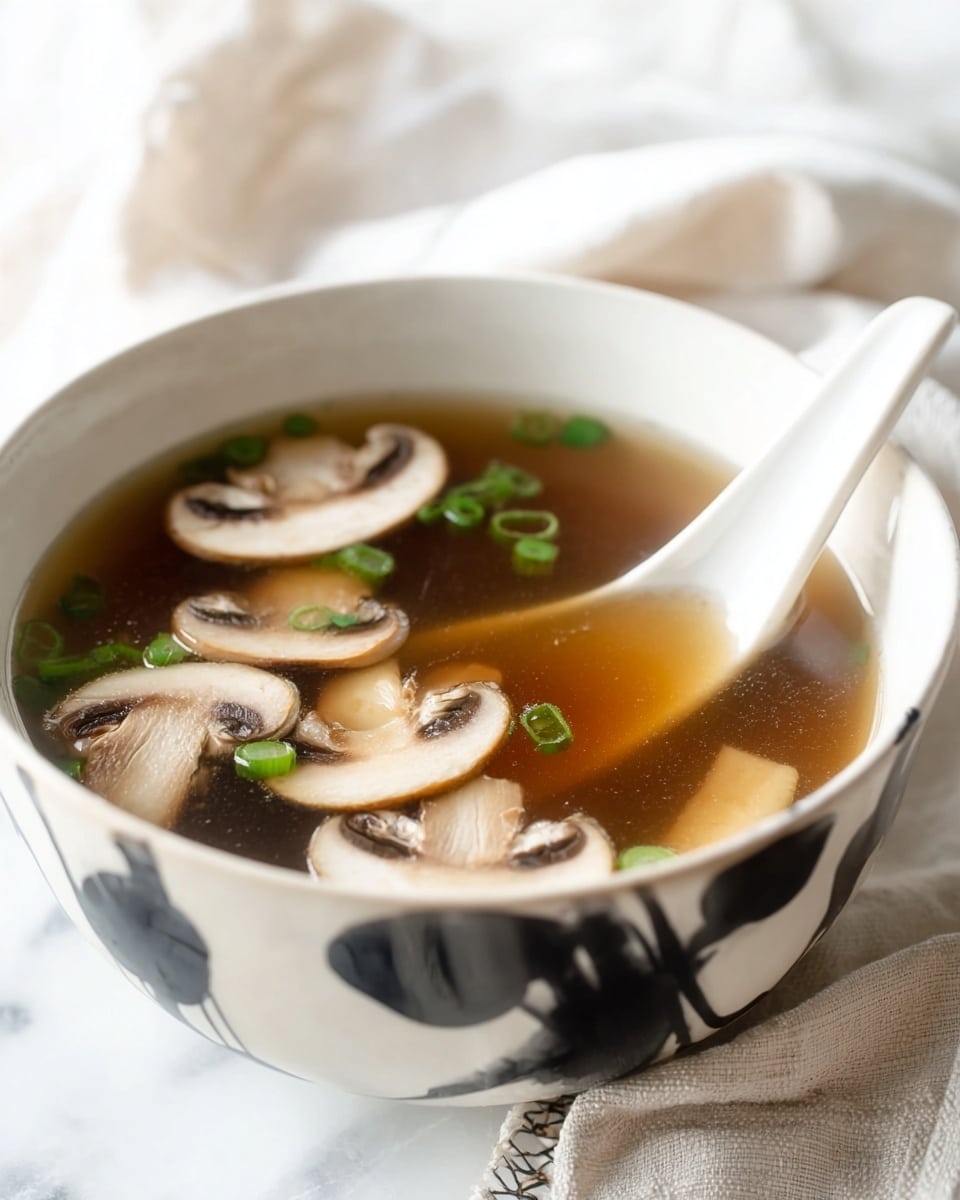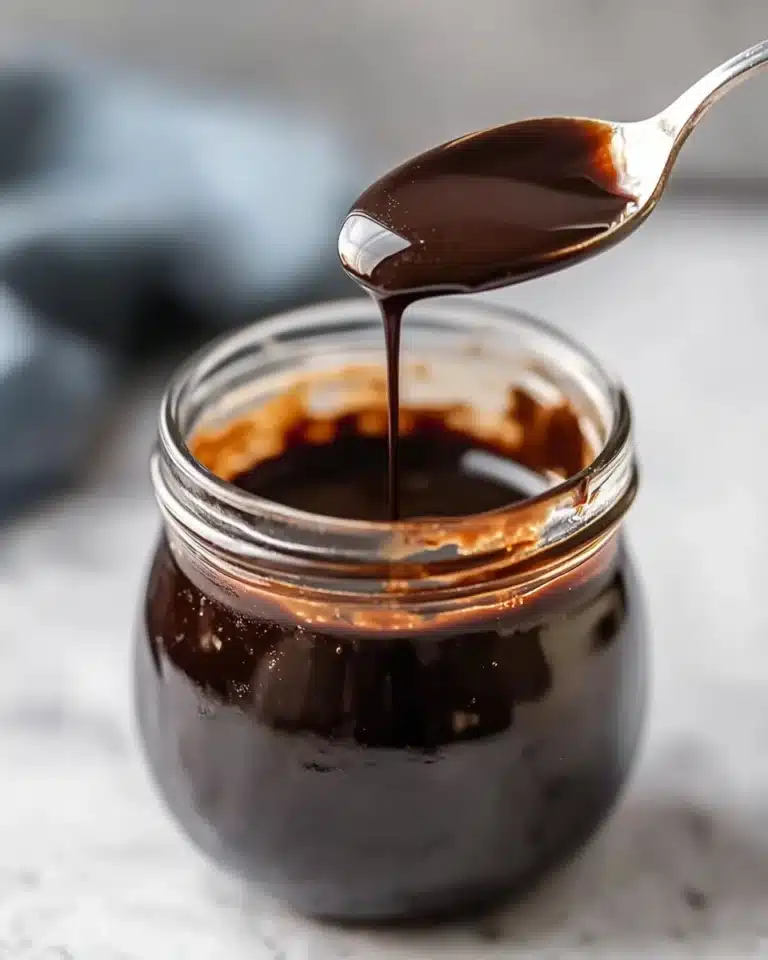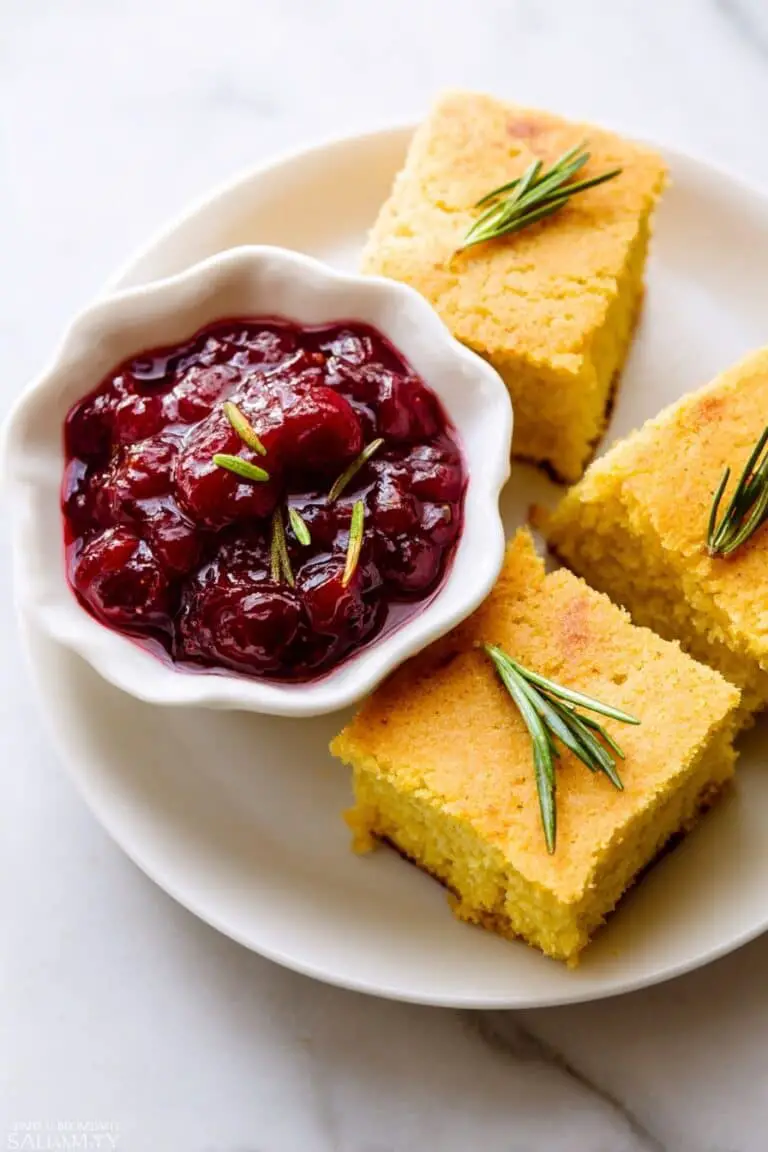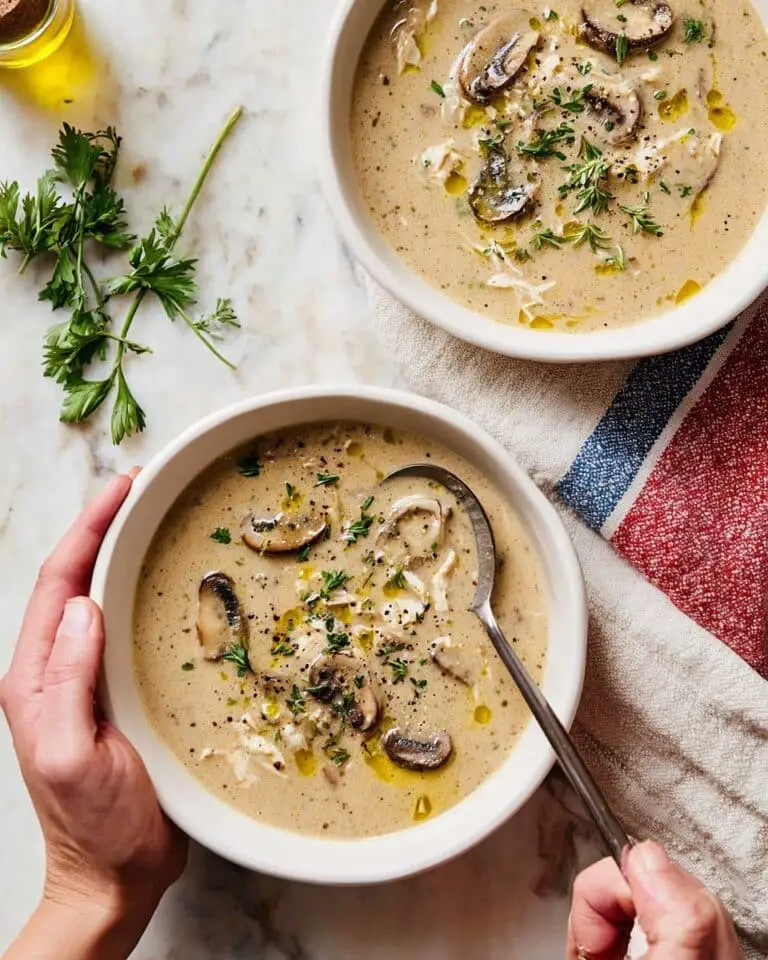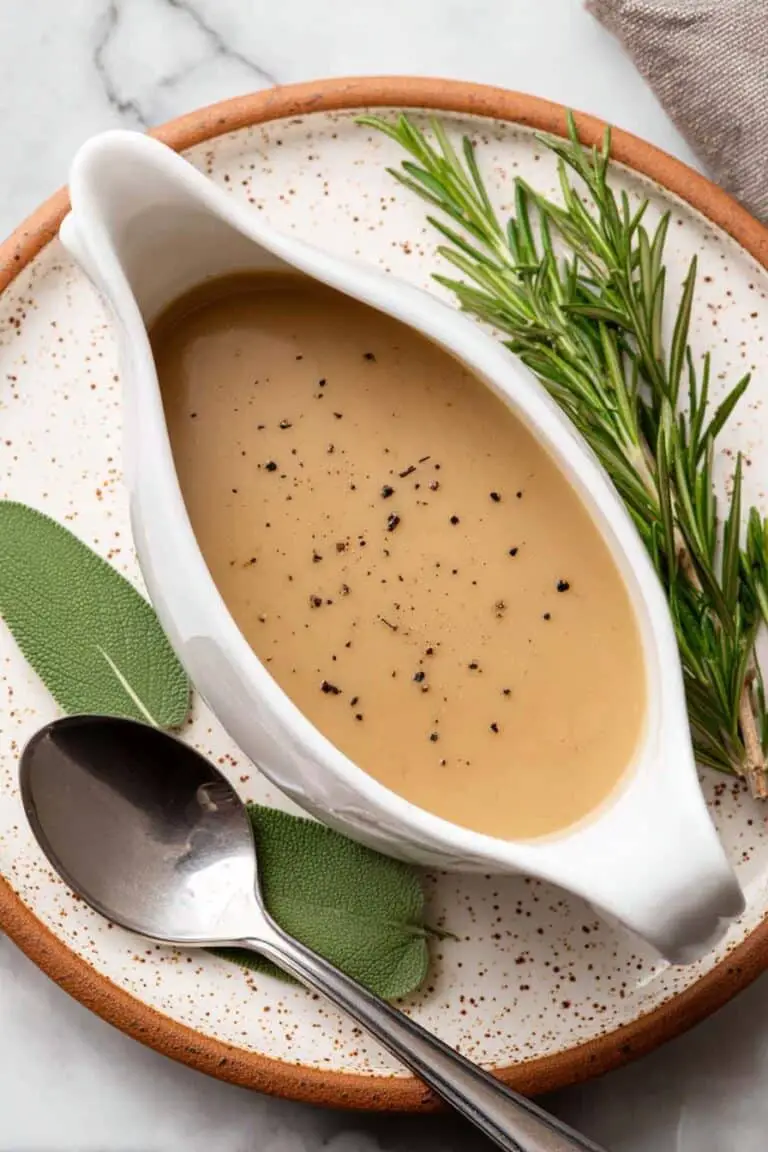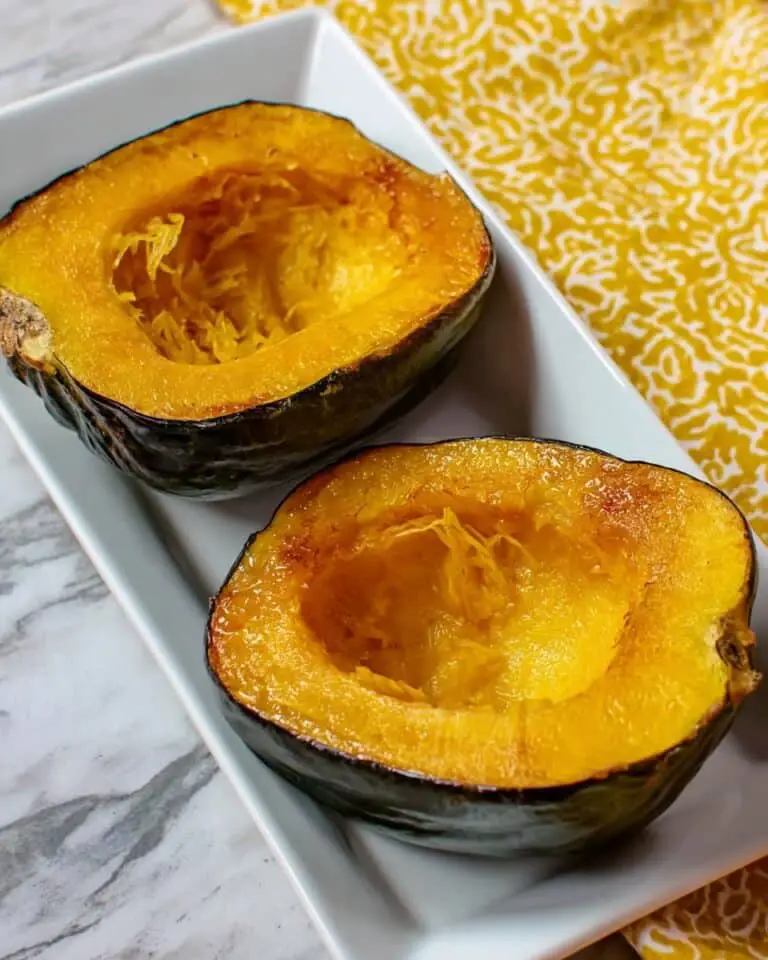If you’ve ever wanted to master a soul-soothing broth that’s light yet deeply flavorful, you’re in the right place. This Japanese Clear Soup Recipe is exactly the kind of recipe I love to make when I want something comforting but not heavy. It’s beautifully simple but packs a punch of umami, and I promise you’ll find it becomes your go-to whenever you crave a warm, clear soup with layers of gentle complexity.
Why You’ll Love This Recipe
- Deep Flavor Without the Fuss: Slow-simmering the combination of chicken and beef broths with fresh aromatics creates a rich broth that tastes way more complex than the effort it takes.
- So Versatile: Whether you want a light appetizer or a soothing main, this soup adjusts beautifully to any occasion.
- Easy Ingredients, Big Impact: The pantry staples and fresh veggies come together effortlessly, perfect for busy weeknights or when you want to impress without stress.
- Comfort in a Bowl: Perfectly clear yet warmly savory, it’s a hug in soup form that my family devours every single time.
Ingredients You’ll Need
Every ingredient in this Japanese Clear Soup Recipe plays a role in building that delicate yet layered flavor. What’s great is that most of these are standard in your kitchen or easy to grab from your grocery store, making it accessible for any home cook.
- Sesame oil (or peanut oil): I love to use sesame oil for that subtle nutty toastiness, but peanut oil works just as well.
- Chicken broth: The base protein element that gives the broth a clean, hearty backbone.
- Beef broth: Adds richness and depth that rounds out the flavor beautifully.
- Water: Dilutes and balances the intense broths, so the soup stays light and clear.
- Sweet onion: Caramelizing it creates natural sweetness and complexity in the broth.
- Garlic: Just smashed, so you get that mellow yet aromatic flavor without the harshness.
- Carrots: Their natural sugar brings a gentle sweetness that marries well with the other veg.
- Fresh ginger: Think of it as the subtle zing that wakes up the broth with warmth and freshness.
- Scallions: These are for garnish, adding a sharp, fresh bite right at serving time.
- Button mushrooms: Thinly sliced, they add earthiness and a lovely textural contrast in every bowl.
- Salt: Adjust at the end; it’s best to season after simmering so you don’t overdo it.
Variations
I love to tweak this Japanese Clear Soup Recipe depending on what’s in my fridge or how I’m feeling. There are tons of ways to customize it without losing the soul of that crystal-clear broth we all adore.
- Add Protein: One time, I lightly poached some tofu cubes right in the broth, and it made a perfect vegetarian version that still felt hearty.
- Seasonal Veggies: In fall, I swapped the button mushrooms for shiitake to up the umami, and it became a whole new experience—but still wonderfully comforting.
- Spice it Up: If you love a little heat, a tiny dash of chili oil on top can awaken the flavors in an exciting way.
- Make it Vegan: Substitute veggie broth for chicken and beef broth, and add plenty of kombu seaweed during simmering for that savory, ocean-like hit.
How to Make Japanese Clear Soup Recipe
Step 1: Sear the Aromatics to Build Flavor
Start by heating your stock pot over medium-high heat and adding the sesame oil. Toss in the onion wedges, smashed garlic, carrot chunks, and sliced ginger. This step is my favorite because seeing those veggies caramelize is when the magic begins—the aroma fills the kitchen and you know you’re onto something good. Just make sure to keep an eye on the garlic so it browns but doesn’t burn.
Step 2: Add Broths and Simmer Long and Slow
Pour in the chicken broth, beef broth, and water, then bring everything to a boil. When it reaches a boil, reduce the heat to low and let it simmer gently for at least one hour. During my first tries, I rushed this step and didn’t get the full depth of flavor—but patience really pays off here. Low and slow lets those flavors meld and intensify, giving you a broth that’s clear but packed with goodness.
Step 3: Strain the Broth and Season to Taste
After the simmer, use a skimmer or slotted spoon to remove all the veggies, leaving behind only that beautiful, clear broth. Give it a taste and season with salt gradually to your liking. It’s better to salt little by little because the broths themselves can have varying saltiness. Taste as you go, trust your palate.
Step 4: Serve Hot with Fresh Mushrooms and Scallions
When it’s time to eat, ladle the hot broth into bowls and top each serving with thinly sliced button mushrooms and chopped scallions. These garnishes add just the right touch of freshness and texture that make each spoonful sing. My family goes crazy for this final touch every time.
Pro Tips for Making Japanese Clear Soup Recipe
- Caramelize with Care: I learned early on that gently searing the vegetables at medium heat avoids burnt garlic bitterness but still develops sweet, layered aromas.
- Simmer Gently: Too aggressive boiling makes the broth cloudy and flat-tasting—keep a gentle simmer, and your soup will stay beautifully clear and flavorful.
- Salt Last: Broths vary in saltiness, so always season at the end to avoid an overpowering soup.
- Fresh Isn’t Optional: Adding fresh mushrooms and scallions right before serving instantly brightens and refreshes the soup—definitely not a step to skip.
How to Serve Japanese Clear Soup Recipe
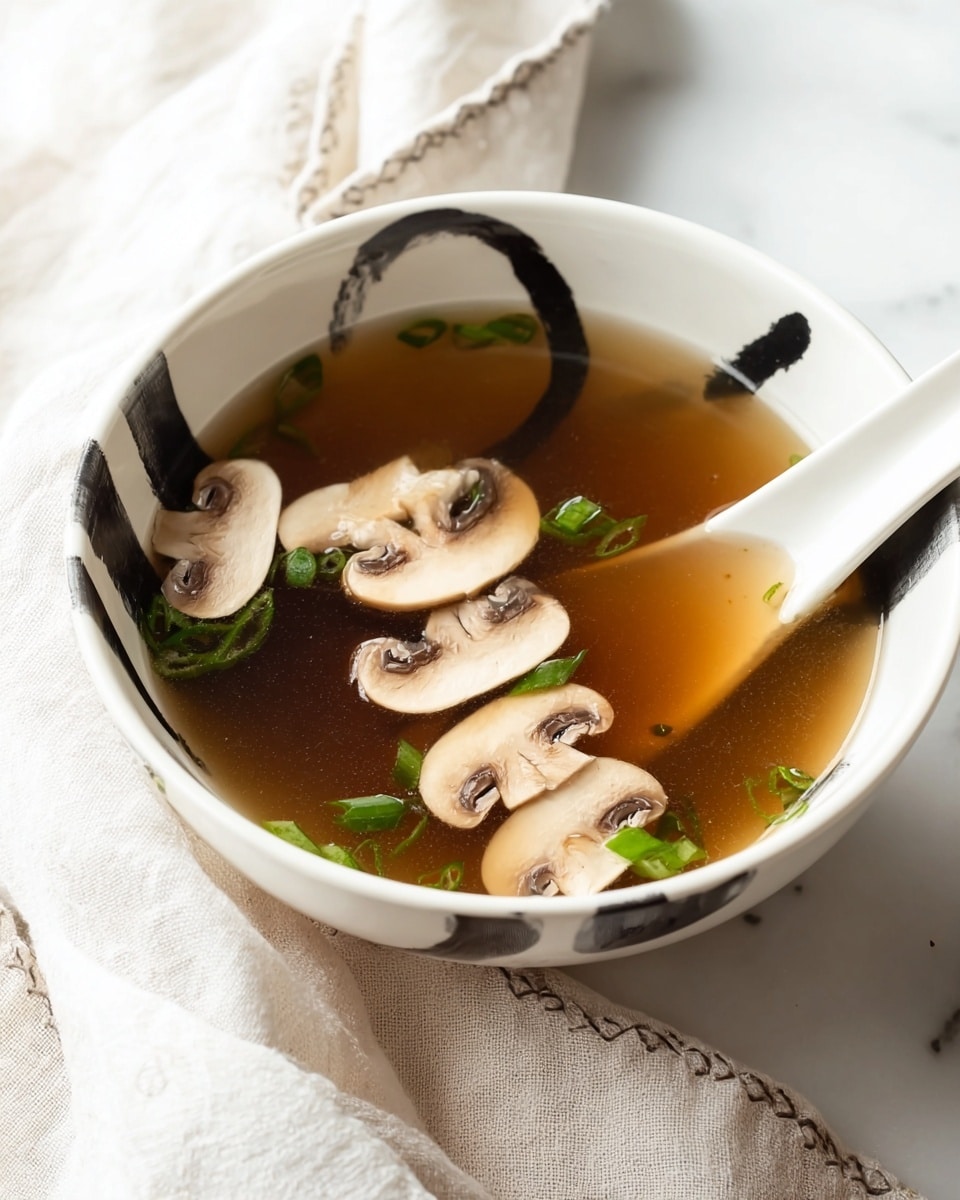
Garnishes
I always stick with thinly sliced button mushrooms and fresh scallions because they add a lovely crunch and subtle earthiness. Sometimes I sprinkle in a few drops of toasted sesame oil at the end for an extra fragrant layer—totally optional but a game-changer in my book.
Side Dishes
This soup pairs beautifully with steamed white rice or simple vegetable tempura. When I want to keep things light, I serve it alongside a crisp cucumber and seaweed salad for a refreshing balance.
Creative Ways to Present
For special occasions, I like to serve this Japanese Clear Soup Recipe in elegant bowls garnished with edible flowers or a few sprigs of mitsuba (Japanese wild parsley). It adds a pop of color and a delicate herbaceous note that guests always comment on.
Make Ahead and Storage
Storing Leftovers
After it cools, I pour leftover broth into airtight containers and keep it in the fridge for up to 3 days. Keeping it separate from the garnishes makes reheating super easy and keeps everything fresh-tasting.
Freezing
This Japanese Clear Soup Recipe freezes really well. I freeze the broth in portion-sized freezer bags or containers and make sure to label the date. When thawed in the fridge overnight, it tastes almost like freshly made.
Reheating
I like to gently reheat the broth on the stove over low heat, stirring occasionally until hot. Avoid boiling it again to keep the clear texture, then add fresh mushrooms and scallions right before serving to keep everything vibrant.
FAQs
-
What makes this Japanese Clear Soup Recipe different from other soups?
This soup relies on the delicate balance of broths and slow simmering with aromatics to create a rich yet clear and light broth, unlike heavier soups that use cream or thickening agents. The clarity and subtle complexity distinguish it.
-
Can I make this soup vegetarian or vegan?
Absolutely! Substitute the chicken and beef broths with a high-quality vegetable broth and add kombu (seaweed) for a boost of umami. You can also add tofu or seasonal veggies in place of mushrooms, adapting it to your preferences.
-
How long should I simmer the soup?
Simmering for at least one hour is key for developing deep flavor without clouding the broth. I’ve found that longer simmering doesn’t necessarily help and can sometimes degrade the clarity, so one hour hits the sweet spot.
-
Can I prepare parts of this soup ahead of time?
Yes! You can make the broth a day or two in advance and refrigerate or freeze it. Just add fresh garnishes like mushrooms and scallions when you’re ready to serve for the best flavor and texture.
Final Thoughts
This Japanese Clear Soup Recipe is one of those comforting staples that I always come back to when I want something simple yet satisfying. It’s a testament to how a few humble ingredients, treated with care and patience, can deliver an experience that’s both elegant and homey. I can’t wait for you to try it and hear how much your family loves it too—just like mine does!
Print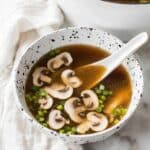
Japanese Clear Soup Recipe
- Prep Time: 5 minutes
- Cook Time: 1 hour 5 minutes
- Total Time: 1 hour 10 minutes
- Yield: 8 servings
- Category: Soup
- Method: Stovetop
- Cuisine: Japanese
Description
This Japanese Clear Soup is a delicate and flavorful broth made by simmering a blend of chicken and beef broths with aromatic vegetables and seasonings. The soup is light yet rich, featuring caramelized onions, garlic, fresh ginger, and a medley of mushrooms and scallions for garnish. Perfect as a warm appetizer or a soothing light meal, this traditional clear soup embodies subtle umami flavors that are both comforting and refreshing.
Ingredients
Broth and Vegetables
- 2 teaspoons sesame oil (or peanut oil)
- 8 cups chicken broth
- 4 cups beef broth
- 4 cups water
- 1 large sweet onion, peeled and cut into wedges
- 6 cloves garlic, peeled and smashed
- 2 large carrots, cut into chunks
- 2 inch piece fresh ginger, sliced
- 4 whole scallions, chopped (for garnish)
- 10 button mushrooms, sliced thin (for garnish)
- Salt, to taste
Instructions
- Sear the Vegetables: Place a large 8-quart stock pot over medium-high heat. Add the sesame or peanut oil and then the onion wedges, smashed garlic cloves, carrot chunks, and sliced ginger. Sear the vegetables carefully on all sides until they begin to caramelize, being cautious not to burn the garlic, which enhances the depth of flavor in the broth.
- Add Broths and Simmer: Pour in the chicken broth, beef broth, and water into the pot with the seared vegetables. Bring the mixture to a rolling boil, then reduce the heat to maintain a low boil. Let the soup simmer gently for at least one hour to allow the flavors to fully develop and meld together.
- Strain the Broth: Using a skimmer or slotted spoon, carefully remove the vegetables from the broth. Taste the soup and add salt gradually, adjusting seasoning as needed to ensure a balanced, clean flavor.
- Serve: Ladle the hot clear broth into bowls. Garnish each serving with a sprinkle of chopped scallions and thinly sliced button mushrooms on top for fresh texture and added taste. Serve immediately while hot.
Notes
- You can substitute chicken and beef broth with vegetable broth for a vegetarian version, though the flavor profile will differ.
- Be cautious when caramelizing the garlic so it doesn’t burn, as burnt garlic can impart bitterness.
- Simmering the broth for longer than one hour can deepen the flavors further if preferred.
- This clear soup is excellent served as a starter or alongside a Japanese meal.
- Adjust salt seasoning at the end to control sodium levels according to your dietary needs.
Nutrition
- Serving Size: 1 cup (240 ml)
- Calories: 60 kcal
- Sugar: 3 g
- Sodium: 550 mg
- Fat: 2 g
- Saturated Fat: 0.3 g
- Unsaturated Fat: 1.5 g
- Trans Fat: 0 g
- Carbohydrates: 6 g
- Fiber: 1 g
- Protein: 3 g
- Cholesterol: 5 mg

